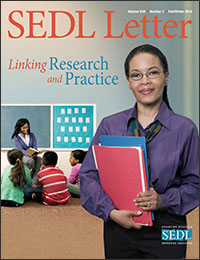Research to Practice: What It Means at the Institute of Education Sciences
Q&A With Tracy Dell’Angela
Tracy Dell’Angela became director of outreach and communications for the Institute of Education Sciences (IES) in mid-2009. In this role, she works to enhance external and internal communications by striving to make the work of IES more accessible to practitioners, policymakers, and the general public.

Q. Research plays a much more prominent role in education practices than it did 10 years ago. What are some of the benefits and challenges of this change?
A. I think educators are no longer looking for fixes based on their gut instincts, on “what they just know to be true.” And I think policymakers are moving away from this notion that there is one big fix out there that is going to cure everything wrong with the American school system. The benefit, of course, is that education reformers are increasingly looking to researchers to provide them with these evidence-based solutions. The challenge for researchers is that they need to be asking those policy-relevant questions, and they need to be able to provide support and findings on an ongoing basis, not at the end of a 5-year study. Another challenge will be providing evidence that is nuanced, that anticipates implementation issues based on school culture and organizational challenges. It’s not enough to ask whether or not a particular program works or doesn’t work; we need to understand why it works, how it works, for whom, and under what conditions.
Q. What are some of the ways that education leaders can bridge the gap between research findings and what is happening in the classroom?
If researchers want their work to be relevant to school improvement efforts, their connection to schools needs to go far beyond just gathering data and observing students and teachers.
questions that are relevant to schools and policymakers. Too often, researchers do a study on something they are interested in, drop the findings on schools, and say: “Here are some good findings you need to use.” Well, it doesn’t work that way. Researchers need to help principals, teachers, and district leaders understand how to use the research to improve their schools. That means they need to think about how to take complicated ideas and make them understandable—to write and present findings in an accessible way for an audience of practitioners who don’t live and breathe regression models and effect sizes.Q. What are some ways that researchers and educators can collaborate to improve education?
A. When researchers listen to the voices of practitioners and policymakers throughout the research cycle—from planning and designing studies to interpreting findings and working through the implications for policy and practice—folks on the ground are more likely to respond to findings and adopt them in schools. If researchers want their work to be relevant to school improvement efforts, their connection to schools needs to go far beyond just gathering data and observing students and teachers. They need to spend time in schools talking with administrators and teachers before and after studies about the challenges they face. They need to reach out to policymakers. And they need to collaborate with researchers outside their own expertise.

Q. What is the IES vision for promoting partnerships between researchers and educators?
A. As I mentioned above, it starts with asking the questions that matter most for practice and policy. IES has already taken a few steps to foster these partnerships. We rewrote our post-doctoral grants to make it clear we are explicitly seeking trained scientists interested in engaging with practitioners and asking more of the relevant questions that really matter to schools. We built language into our Request For Application competitions that encourage—and in some cases require—collaboration between researchers and schools. We just launched a major initiative out of our National Center for Education Research—the Reading for Understanding Research Network, a $100 million commitment that will bring together 130 researchers working in partnership with teachers and school leaders to tackle a critical need: improving reading comprehension for all students from preschool through high school. And a new project out of the National Center for Education Evaluation and Regional Assistance— the evaluation of the impact of the American Recovery and Reinvestment Act (ARRA), the federal stimulus funds for education—will demand a new responsiveness and regular communication with policy leaders, states, and districts. We will be conducting impact studies of school turnarounds and evaluating the Teacher Incentive Fund programs, and our goal is to turn these reports around more quickly than we have in the past, so we can help the department and states make midcourse corrections as needed.
Q. Schools and districts have access to more data than ever before. What are some strategies that can help them create meaning out of the numbers?
A. We can harness our vast resources and experience, particularly with data systems, to help states make productive use of the ocean of data in which they are now swimming . . . or drowning, as the case may be. In May, we announced grant awards totaling $250 million to 20 states for the design and implementation of these systems. These grants, funded through ARRA, will promote the linking of data across time and databases, from early childhood into career, including matching teachers to students. Up until now, the states’ focus has been on building these systems, not using the data to drive improvement at the policy level and at the school level. So there are increasingly robust and rich data systems out there that a lot of users simply don’t know how to use best. We can play a big role in developing partnerships—perhaps through training grants or our regional labs—with district and state data experts that will support their efforts to provide timely, descriptive, and analytic feedback to their schools.

Next Article: SEDL News

